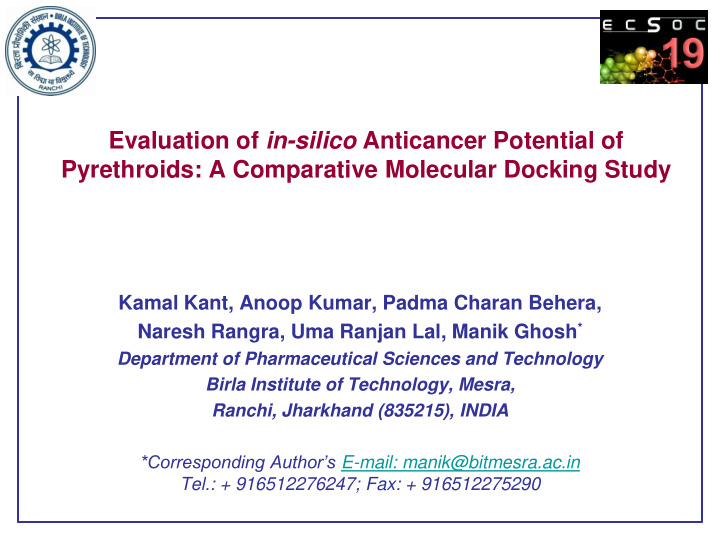



Evaluation of in-silico Anticancer Potential of Pyrethroids: A Comparative Molecular Docking Study Kamal Kant, Anoop Kumar, Padma Charan Behera, Naresh Rangra, Uma Ranjan Lal, Manik Ghosh * Department of Pharmaceutical Sciences and Technology Birla Institute of Technology, Mesra, Ranchi, Jharkhand (835215), INDIA *Corresponding Author’s E-mail: manik@bitmesra.ac.in Tel.: + 916512276247; Fax: + 916512275290
Evaluation of in-silico Anticancer Potential of Pyrethroids: A Comparative Molecular Docking Study 2PIT Resmethrin ( Type 1 Dockin Pyrethroid ) Cancer g Cells 3F81 Fluvalinate (Type 2 Pyrethroid) 3ERT 2
ABSTRACT Pyrethroids have shown promising potential to induce apoptogenic signaling pathways. Therefore, present study on pyrethroids was designed to unlock better alternative agents against cancer disease. Different targets such as estrogen (PDB: 3ERT), androgens (PDB: 2PIT) & cervix (PDB: 3F81) cancer receptors were used in the study. Type 1 & type 2 pyrethroids were subjected to docking simulations using Maestro 9.2 version (Schrodinger’s LLC). Pyrethroids (Type 1 & type 2) docking studies have revealed varying glide score to cancer receptors. Resmethrin exhibited better binding interaction to estrogen (Glide Score: -7.32) & androgens (Glide Score: -7.47) while fluvalinate against cervix (Glide Score: - 4.54) protein receptors. Decrease in glide score be evidence for greater bond stability with protein. Based on the current finding from docking studies, these priliminary results may act as effective precursor tool for development of pyrethroids as promising anticancer agents. However, furthermore experimental validation using in-vitro & in-vivo studies is needed to explore their therapeutic & toxic effects. Keywords: Pyrethroids; anticancer agents; docking; cancer receptors 3
Introduction In the last few years, Cancer has become an important leading precursor towards mortality rate (8.2 millions, 2012) & estimated to increase via almost 70% over the next two decades. Although, the various synthetic drugs have shown promising potential against this disease but poor selectivity issue remains major concern. Recently, a hypothesis has been proposed in which it has been shown that at lower concentration, pyrethroid can induce apoptogenic signaling pathways in various cancer cells. Pyrethroids (type 1 & type 2) are sound synthetic insecticide compounds derived from the phytoconstituent (pyrethrins) of Chrysanthemum cineraraefolum . Chemically, the type 2 pyrethroids such as deltamethrin and fenvalerate show an α -cyano phenoxy benzyl moiety while the type 1 pyrethroids such as permethrin lack this moiety. 4
The main reward with pyrethroid insecticides are their photo stability, high efficacy at low concentrations, easy disintegration and low toxicity to birds and mammals. Recent studies on pyrethroid have shown its role by activating the apoptogenic signaling pathways against OC2 & Glioblastoma human oral cancer cells. These results reveal that pyrethroids at lower concentration may have a beneficial effect by activating various apoptogenic signaling pathways in the cancer cells. Therefore, in the present investigation, we have tried to assess the in-silico interactions of pyrethroid derivatives against different cancer proteins (estrogen, androgen & cervix). 5
Results and discussion Table: Glide score of type1 & type2 pyrethroids against cancer receptors (PDB: 3ERT, 2PIT & 3F81) Sr No. Name of the Glide Score Glide Score Glide Score compounds (3ERT) (2PIT) (3F81) 1 Resmethrin -7.32 -7.47 -2.78 2 Cyhalothrin -7.16 -7.17 -1.12 3 Permethrin -6.27 -5.13 -2.45 4 Cyfluthrin -6.02 - -2.52 5 Fluvalinate -5.81 - -4.54 6 Flucythrinate -5.70 - -2.27 7 Tetramethrin -5.07 -2.25 -2.15 8 Bifenithrin -4.12 - -2.62 9 Fenproparthrin -3.99 -5.61 -2.65 10 Tefluthrin -2.87 - -1.73 11 Phenothrin - -6.04 -2.57 12 Deltamethrin - -6.17 -2.50 13 Flumethrin - - -2.46 14 Tralomethrin - - -2.14 15 Cypermethrin - -2.19 -1.96 16 Fenvalerate - - -1.80 17 Allethrin - -6.43 - 18 *Reference -9.19 -8.25 -3.18 * Reference ( 3ERT: 4-HydroxyTamoxifene, 2PIT: 5-Alpha-Dihydrotestosterone & 3F81: 2-(5-methyl-4-oxo-2-thioxo-2,4- dihydro-3H-1lambda~4~,3-thiazol-3-yl)ethanesulfonic acid) 6
Binding Interactions of Pyrethroids against cancer receptors Resmethrin (2PIT) Resmethrin (3ERT) 7
Fluvalinate (3F81) The reports have revealed that resmethrin possess higher binding affinity with estrogen (Glide Score: -7.32) & androgens (Glide Score: -7.47) proteins while fluvalinate (Glide Score: -4.54) against cervix receptor. 8
Conclusions Top screened pyrethroids like resmethrin (3ERT & 2PIT) & fluvalinate (3F81) have resulted in most hopeful hits to anticancer assessment. The widespread applications of pyrethroids among population have turned researchers focus to unlock its novel potential and thus this recent preliminary molecular docking study can serve as an important breakthrough to further understand its anticancer nature with its clear mechanism. However, the complete efficacy and safety studies should be assessed to start a clinical trial for these compounds. 9
Acknowledgments 10
THANK YOU 11
Recommend
More recommend